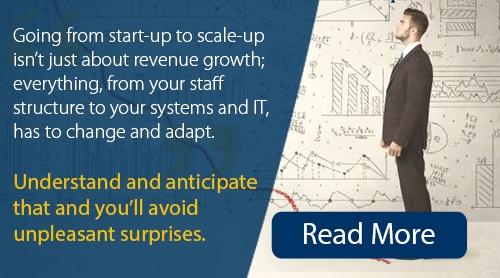
Whatever your business, whether it’s commercial or a charity or not-for-profit, if you grow significantly there will be major implications on how you fund the growth and manage the cash.
VIstage Speaker, Jo Haigh, puts it like this: “You can trade profitably for ages, but you can only ever run out of cash once.”
James Nicholson-Smith, Director, FD Centre also warns: “Unless you’re really determined you need the funding and have a really good reason for it, this whole funding bit can be a massive distraction to the business. Go into it with your eyes wide open, knowing that it’s going to take a big, big chunk of your time.”
Funding your growth
Although good cash management can help you finance growth, in most organisations, some form of additional funding is needed. The past few years have changed the finance landscape, and so while traditional finance routes still exist, there are now many more options available to businesses. Matching the right finance to your situation and future needs can be a challenge. To make the right choice, you need to go back to some basics. Ask yourself: “Why do I need funding?”
Even in a growth phase, you need to be sure if you really need funding and also what type of funding you will need.
James Nicholson-Smith asserts: “You often find that people need funding to patch up something that’s gone wrong and that’s not always a very good starting point. Funders don’t like filling in gaps where things have screwed up previously. They want to fund a project that’s going to deliver value. The follow on point to that is that if the funding is to cover up an inefficiency in the other elements of planning, it may be that funding is not where you should be putting your efforts. You should try and think about doing the business in a different way that doesn’t require the funding.”
“If I do need funding, am I looking for debt funding or am I looking for equity funding?”
There are two types of funding: There is working capital and capital funding or put another way, there is debt and equity
Unfortunately, people often get the wrong kind of money. For example, using working capital for capital expenditure; securing debt funding when it’s really an equity play because the outcome of what you’re doing is uncertain; exposing yourself to uncertainty with overdrafts; and exerting efforts in gaining a funding that you in practice don’t have time to secure.
There’s a big difference between equity and debt funding. A debt funder (providing a loan) definitely wants to be paid back and at a certain return defined at the time the money is put in. Therefore the risk profile is going to be very, very different to equity. An equity funder knows that there is an uncertain return and an uncertain repayment date on the funding, and therefore will expect a much, much higher rate of return. You’ve got to know which one you’re after. You’ve also got to be thinking about, “When do I need funding and how long is it going to take me to actually get it?”
Don’t leave it too late to get funding
A lot of people unfortunately leave it far too late to get funding and then wonder why they’re unsuccessful in securing it. Rushing or starting too late can find you the wrong money at the wrong price, with the wrong people – or alternatively you just run out of time altogether.
If you’re a single shareholder, then the decision is basically yours. But the moment you’ve got multiple shareholders or shareholders that are not currently involved in the business you need to consult with them because they might not be very happy leveraging up the business or diluting their shareholding.
Those are the other questions that you need to ask and consider before you go diving into securing funding.
Funding without the banks
Jo Haigh’s advice is: “I am more and more inclined to suggest now that people look at peer-to-peer lending. Because, whatever banks say, they will typically only lend to a sure winner. I’d lend to a sure winner; I’d put my children’s inheritance on a sure winner.”
“Now there is no risk capital at all, even the so-called private equity houses and venture capitalists are hugely risk-averse, whatever they say. This is the UK. I am not necessarily saying this is international. “I spoke to one business leader and he told me that his bank, after more than 20 years, suddenly decided that they didn’t want to be in his industry.”
“He was in a situation, employing 30-odd people; they are manufacturers. They had a lot of skills that he didn’t want to lose. He had less than seven days to pull in £200,000, which is quite a hefty sum for peer-to-peer lending. He got it through a company called Funding Circle, and his words were, ‘It saved my life and my company and I’ve gone back to them again.’”
“And he said, in the time it can take to get the bank manager to return my call, Funding Circle had got the money in my bank.”
The rise of peer-to-peer funding Jo Haigh says: “Because of the speed and the spread of risk for the people putting it (money) in, I think it is a massively sensible alternative. I’m not going to say that the first one you contact is going to lend it to you, but I think peer-to-peer lending makes sense”.
How does peer-to-peer lending work?
1. Find a peer-to-peer lending website.
2. Pitch your idea or requirement and say how much you need. The amount you ask for can vary from a few pounds to hundreds of thousands.
3. Lenders pledge their offer via the website at a selected interest rate.
4. The lowest interest rate bidders, if all the funding is raised, lend you the money.
5. Depending on the nature of the peer-to-peer lending organisation, you might be assessed by a lending manager and graded, as to whether this is a very good risk, or it is a very high risk, or whatever.
6. Lending decisions and the money being made available can take a little as a couple of days.
7. You end up with a spread of maybe even 150 lenders. And for the actual funders it can be a very good return, because it is not the cheapest money. It can cost you 5-8% as a guide.
Importantly, this is available money. Bank money can be too slow. While bank interest rates are still at an all-time low, they still want to lend at 5 and 6% above base. If you are paying 7% with peer-to-peer, it is a viable option.
Confidential invoice discounting
Another type of funding that is really good for working capital is confidential invoice discounting. If used properly, and you negotiate well on the terms, it works well.
Jo Haigh gives this example: “We did an MBO recently. It was a very profitable business, but the whole MBO funding was done on invoice discounting. Just over 12 months later nearly all of that has been paid back. Not through a loan, but through the generation of cash in the business. Because that is how invoice discounting works.” It does come at a cost though.
Invoice discounting is much more expensive than straightforward financing, because not only do you pay a percentage of the money that you are borrowing, but you also pay a percentage of your ledger; if your ledger is a million pounds and your rate is 1-2% for example, you pay a charge of that amount on top of whatever the cost of the money is. However, in return you don’t have loan repayments every month, or every quarter, that you might not be able to pay.
Confidential invoice discounting works as long as you’ve got increasing sales, or at least level sales, it doesn’t work if you are in a dip position. Jo also has this warning for smaller companies: “Only standard factoring is going to be available for smaller businesses. They won’t do confidential invoice discounting in smaller businesses, because it is much higher risk.”
“I don’t say this is a panacea. Although it is a great product, there are lots of issues related to it. If you’ve got debts that they don’t like, or if you’ve got a large amount of business with a wrong client, or you are in the business of selling a product that is sold in parts, such as a building project, then they won’t fund it. “The whole idea is if there is an issue, you can get the products back.” You can also find some invoice discounters offering spot discounting of a small number or nominated few clients.
Any advice or tips on managing funding throughout a significant growth period?
Plan ahead, keep planning, keep thinking about the different alternative outcomes and be utterly vigilant about that. Keep your eyes and ears open for alternative types of funding. Sometimes the funding that works at the beginning of the journey might not work as you continue through the journey.
When you start achieving significant growth others, like suppliers and customers, are going to be watching you and there might be opportunities for swapping over to a more trade-based funding stream; extended credit or someone paying you advanced payments or maybe even joint ventures that weren’t there on day one and you now need to think about.
That said though, if you’re starting on a growth journey that is three to five years and you choose the equity route, you probably want to think about building one relationship for the whole way – someone or a group who have bought into the fact that they are there for the ongoing phases of funding.
This can be particularly true when it’s an equity play because the people who have invested in the first year, they’re going to get diluted in the second year, and they might get diluted again in the third year. If they don’t know that’s coming, you’re going to have a fight on your hands.
Finally, a lot of business leaders are really good at getting interest in their business and then kick themselves when they can’t actually get the deal over the line or they get the deal over the line and then it doesn’t stick throughout the duration.
The missing ingredient can be investor confidence, whether it’s debt or its equity. After you’ve got someone’s money you need to keep telling them that you’re going to look after their money. So to get a deal across the line, you’ve got to show them how you’re going to look after their money. Then after you’ve got it, you prove to them that you are a safe pair of hands and you have got good corporate governance. You are going to tell them everything that’s going on, good, bad, and the ugly.
That encourages them to stick with you for the rest of the journey. So good investor confidence through good corporate governance and being open and honest with a funding partner, always pays dividends.
More from Vistage:


